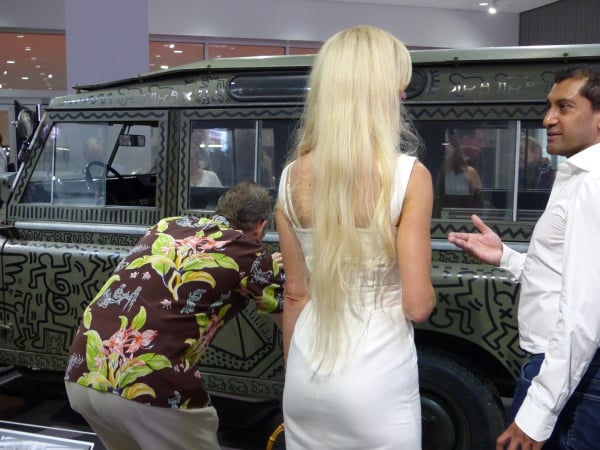
Mario Andretti doesn’t get brought up much during a VIP art opening, unless it’s to say how fast you had to drive on the 10 freeway to make it there. But there he was, dangling from the lips of Adam Langsbard, Chief Marketing Officer of the Petersen Automotive Museum, on July 28 to an audience seated around a canvas-covered object. The object was later revealed to be a 1971 Series III Land Rover painted by late street artist Keith Haring in 1983, and covered in lettering that suggests that it was painted for the Montreaux Jazz Festival.
Langsbard introduced a two-man panel starring street artist Kenny Scharf and Adam Lindemann, collector of automobiles—including a 1965 Shelby Mustang, he would tell the audience. “My other car is an Uber,” he would quip to a snickering audience.
Lindemann is also a collector, an art writer, and the owner of the Venus Over galleries in Manhattan and Los Angeles. Lindemann and Scharf—Haring’s former New York roommate—discussed the early ’80s in New York.
“Me and Keith and Basquiat were kind of a little bit of a trio,” said Scharf, explaining why cars and/or walls could be canvases. “We were anti-elitist. We thought that art is not some secret club that only those who went to college and studied art history could enjoy. We didn’t want to alienate those people either, but to take art to both. It was very socialistic.”
Lindemann and Scharf considered the Land Rover. The hulking, army green beast is covered in Haring’s figures like tattoos on a sailor’s body. During a question-and-answer session, an audience member asked Scharf just what Haring’s figures and scribbles were getting at. “He tacked very many subjects—the culture of television, the idea of the end of the world and nuclear annihilation—but the thing to remember,” said Scharf, “is that even before everyone knew his characters, they were iconic; they were symbols. He was using symbolism. He studied semiotics. I think he was trying to create his own language. Anyone from any culture can read it.”
Lindemann then drew a distinction between Haring’s Land Rover, which he viewed as “non-commercial in any way,” and the BMW Art Cars by David Hockney, Alexander Calder, and Robin Rhode that are currently on view at the Petersen. “BMW was hiring those artists,” said Lindemann.
“I doubt [Haring] chose this car,” Scharf piped in. “The car probably presented itself to him as a canvas.”
Scharf himself has spray-painted over 200 cars for his “Carbombz”—which he offers to anyone for free as a reaction to “the boring beige car design of the past 40 years”—he told me after the talk, and made 10 custom cars that are further augmented into fully realized artworks.
One such work will be on view at Lindemann’s Venus Over Los Angeles during “Piston Head II: Artists Engage the Automobile,” which will also feature vehicle-inspired work (or literally carworks) by dudes like Matthew Day Jackson, Richard Prince, Sterling Ruby, Lawrence Weiner, Haring, and Scharf—as well as dudette Katherine Bernhardt. Scharf pines for the days when cars had personality. He himself drives a 1959 Cadillac Fleetwood “about once a week, but for a daily driver, it’s a Prius that I’ve carbombed, and an old Miata I’ve had since ’92.”
After the talk, the demographics of the audience became clear when I heard one woman, referring to Keith Haring’s work, say, “It reminds me of the Soulcycle logo.”
Another woman, speaking to Scharf about his free Carbombz, was a bit confused. “When you say bombing…” Scharf assured her that meant painting in street art parlance. A few people did rock Haring products, including a stylish gentleman in a puffy vest adorned with colorful Haring people.
But generally, the crowd milling about was much more automotive-minded, really bringing into perspective the collective hush that fell when Scharf admitted to the crowd of mostly motorheads that he tends to be anti-automotive industry. “I like batteries,” he said about his Prius, something of a controversial statement in the museum. “I love car culture, but at the same time petroleum is the scourge of the world.”